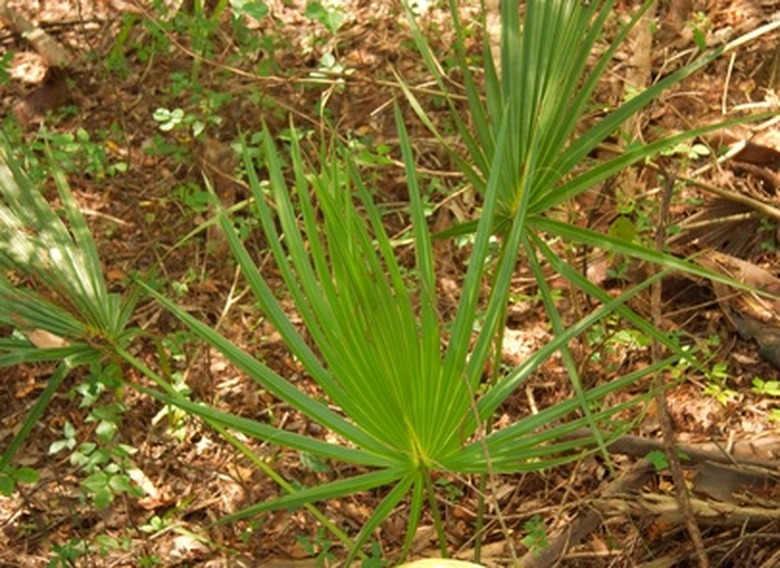How To Separate A Palm Clump
We may receive a commission on purchases made from links.
Palm trees are members of the Arecaceae family and are hardy in U.S. Department of Agriculture plant hardiness zones 6 through 12, depending on the species. In size, palms range from 1 to 200 feet tall, again depending on the species. While palm trees cannot be reproduced by cuttings, some palm species produce offshoots that are genetically identical to the parent palm. If your tree has produced offshoots, you can separate a palm clump to make more plants for your indoor or outdoor garden.
Palms That Produce Offshoots
Palms That Produce Offshoots
Not all palm trees produce offshoots, and not all "palms" are actually members of the palm family. Date palms (Phoenix spp.), hardy in zones 9 through 11, are often propagated by offshoots to ensure the consistency and quality of the dates. The Mediterranean fan palm (Chamaerops humilis) tolerates cooler temperatures in USDA zones 8 through 11. It also reproduces by both seeds and offshoots.
Areca palms (Dypsis lutescens), often grown as houseplants, may also produce offshoots. These small palms only grow 6 to 8 feet tall when maintained in a container indoors. Hardy in USDA zones 10 and 11, areca palms can be taken outdoors for a summer vacation but bring your plant back inside before temperatures drop in the fall.
While not actually palms, both the ponytail palm (Beaucarnea recurvata) and sago palm (Cycas revoluta) also produce offshoots that can be separated from the parent plant. While the ponytail palm prefers the frost-free climates of USDA zones 10 and 11, sago palms are perennials in USDA zones 9 through 12.
Before You Begin
Before You Begin
Before you begin to separate a palm clump, put on safety goggles, thornproof gloves, long sleeves and other protective gear to protect your eyes and skin. Some palm species have thorns or sawtoothed edges on their stems, and all parts of the sago palm are poisonous.
Sanitize all of your tools by dipping the metal cutting blades in rubbing alcohol. Alternatively, you can dip a rag in the alcohol and wipe the tools between cuts.
Things Needed
How to Separate a Palm Clump
1. Prepare the Flower Pots
Fill new flower pots with a well-draining potting mix. If you prefer to mix your own, combine 3 parts peat moss or coconut coir with 1 part coarse sand. Alternatively, combine 6 parts peat moss or coconut coir, 1 part sand and 3 parts medium-size bark. Wet the mix thoroughly and then fill one or more flower pots two-thirds full and set them aside.
2. Separate the Offshoot
Carefully brush the soil away from the base of the offshoot. It must have roots, as palms cannot root from stem cuttings. If the offshoot hasn't developed roots, replace the soil and wait a few more months.
Separate the offshoot and its roots from the parent plant by cutting downward between the stems with a garden knife. Tug gently to pull the offshoot away from the palm. If it resists, remove more soil as needed until the offshoot's roots are free.
Immediately place the offshoot's roots in a bowl of water and let them soak for up to an hour while separating any other offshoots unless it's a sago palm. Set sago palm offshoots aside to dry for a few days before planting. Replace the soil around the parent plant's roots and tamp gently. Water thoroughly to settle the soil and remove air pockets.
3. Plant the Offshoot
Dig a hole in the center of the potting mix, then settle the offshoot in its new home. Set the young palm at the same soil level as it was when attached to the parent plant. Add more moist potting mix as needed, leaving a 1 to 2 inch space between the rim of the pot and the soil.
Water thoroughly before placing the flower pot in a brightly lit, warm location. Keep the palm out of drafts from air conditioning and heating vents. Water regularly to keep the potting mix evenly moist but not waterlogged. Fertilize from spring through summer, either two or three times with a slow-release fertilizer formulated for palm trees or monthly with a 19-6-12 fertilizer with micronutrients.
4. Separate Palm Clumps
When kentia palms (Howea forsteriana, zones 9-11) and other tropical palm species are sold as parlor palms, they are often multiple plants grouped together in one container. While this provides a lush, multistemmed palm, the crowded container also stunts the growth of the palms. With care, you can divide a parlor palm into two or more clumps.
Remove the palm from the flower pot and then run lukewarm water over the roots to remove the soil. The roots will be tangled together, but you can gently tease them apart. Keep the roots moist as you separate the palm into several smaller clumps and replant with fresh potting mix.
References
- Clemson Cooperative Extension: Indoor Palms
- Arizona State University: Chamaerops humilis
- North Carolina Extension Gardener Plant Toolbox: Dypsis lutescens
- University of Florida IFAS Extension: Beaucarnea recurvata: Ponytail Palm
- Arizona State University: Cycas revoluta
- North Carolina Extension Gardener Plant Toolbox: Howea forsteriana
